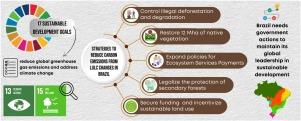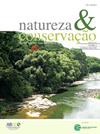Challenges for reducing carbon emissions from Land-Use and Land Cover Change in Brazil
IF 3.5
2区 环境科学与生态学
Q1 BIODIVERSITY CONSERVATION
引用次数: 0
Abstract
Brazil, a crucial player in global climate change mitigation, faces challenges in reducing its carbon emissions, of which nearly half are from land use changes. Despite potential reductions that can be achieved through halting deforestation and fostering forest restoration, setbacks in environmental governance have heightened emissions. This article assesses challenges and proposes solutions for conserving and restoring Brazilian biomes in line with the Sustainable Development Goals (SDGs) and the Paris Agreement by 2030. Notably, net carbon emissions from land-use change and forestry increased twofold from 2017 to 2022 due to deforestation in the Amazon and Cerrado. Native vegetation clearing peaked at 2.8 Mha in 2022, the largest area since 2008. The deficit of native vegetation within Legal Reserves and Permanent Protection Areas must be addressed through restoration. Achieving SDGs by 2030 demands urgent action against illegal deforestation, reinforced legislation for secondary forest protection, large-scale restoration programs, and economic incentives for forest conservation through payment for ecosystem services to rural landowners.

减少巴西土地利用和土地覆盖变化产生的碳排放所面临的挑战
巴西在减缓全球气候变化方面发挥着重要作用,但在减少碳排放方面却面临着挑战,其中近一半的碳排放来自土地利用的变化。尽管通过停止砍伐森林和促进森林恢复有可能实现减排,但环境治理方面的挫折加剧了排放量。本文根据可持续发展目标(SDGs)和《巴黎协定》,评估了到 2030 年保护和恢复巴西生物群落所面临的挑战,并提出了解决方案。值得注意的是,从 2017 年到 2022 年,由于亚马逊和塞拉多地区的森林砍伐,土地利用变化和林业的净碳排放量增加了两倍。2022 年,原生植被砍伐面积达到 280 万公顷的峰值,这是自 2008 年以来最大的砍伐面积。必须通过恢复来解决法定保护区和永久保护区内原生植被不足的问题。要在 2030 年之前实现可持续发展目标,就必须采取紧急行动打击非法砍伐森林行为,加强二级森林保护立法,实施大规模恢复计划,并通过向农村土地所有者支付生态系统服务费用,为森林保护提供经济激励。
本文章由计算机程序翻译,如有差异,请以英文原文为准。
求助全文
约1分钟内获得全文
求助全文
来源期刊

Perspectives in Ecology and Conservation
Environmental Science-Nature and Landscape Conservation
CiteScore
7.80
自引率
4.30%
发文量
46
审稿时长
59 days
期刊介绍:
Perspectives in Ecology and Conservation (PECON) is a scientific journal devoted to improving theoretical and conceptual aspects of conservation science. It has the main purpose of communicating new research and advances to different actors of society, including researchers, conservationists, practitioners, and policymakers. Perspectives in Ecology and Conservation publishes original papers on biodiversity conservation and restoration, on the main drivers affecting native ecosystems, and on nature’s benefits to people and human wellbeing. This scope includes studies on biodiversity patterns, the effects of habitat loss, fragmentation, biological invasion and climate change on biodiversity, conservation genetics, spatial conservation planning, ecosystem management, ecosystem services, sustainability and resilience of socio-ecological systems, conservation policy, among others.
 求助内容:
求助内容: 应助结果提醒方式:
应助结果提醒方式:


